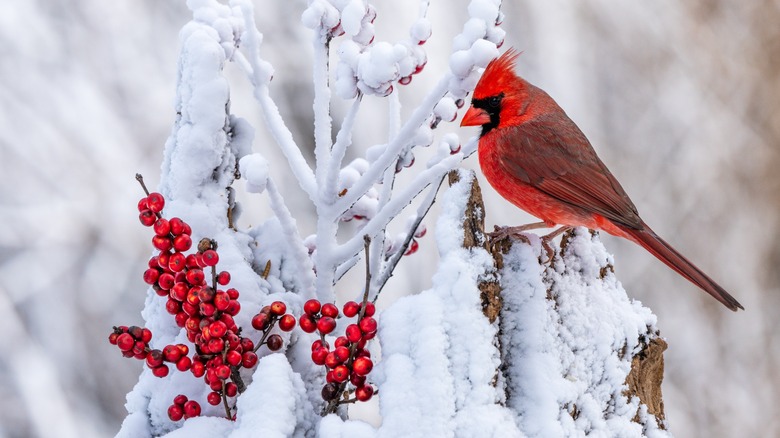The Stunning Tree That Keeps Birds Coming Back To Visit Throughout Winter
When winter settles in, pretty birds like cardinals are hard-pressed to find their favorite foods, like insects and flower seeds. Keep your backyard birds happy with an abundant food source during chilly weather: The wild apple tree (Malus sylvestris). Cardinals, robins, and many more love the late-blooming fruit and berries that the tree provides.
More commonly known as crab apples, wild apple trees hold on to their fruit for a long time — often well past the first snow. And birds won't just eat fruit from branches. They'll also hunt for the fruit that falls to the ground. The high carb count of wild apples, as well as their abundance of vitamin C and potassium, make them a healthy meal choice, especially in the winter when every calorie is needed. Birds aren't the only ones that can enjoy the fruits, though. People can eat them if they avoid the poisonous seeds. Crab apples might be too tart for most to enjoy, though, so they're probably better used for baking recipes than eaten raw.
Wild apple trees are useful in the spring, too. Some varieties offer pretty blooms that attract bees and other pollinators, like white-flowering crab apple trees. These deciduous trees can grow to be more than 30 feet tall, but tend to be pretty compact compared to other trees. They come in a variety of sizes and shapes (including 900 cultivars and counting) with fruit that softens at different times of the year. Most prefer USDA Plant Hardiness Zones 4 through 8.
Picking and planting the right variety of wild apple tree
When picking the right kind of wild apple tree to nourish birds in the winter, know that some varieties grow fruit in the fall ('Cinderella' and 'Jack Siberian') and others bloom later in winter, like 'Prairifire' and 'Profusion'. 'Birdland' or 'Ormiston Roy' might feed birds from fall right through until spring. You also want to avoid cultivars birds don't like to eat, such as 'Firebird', 'Red Jewel', 'Donald Wyman', and 'Adams'.
If you are already growing one in your yard, you can propagate that crab apple tree by using softwood cuttings — the freshly flushed new growth of a branch. Remember that, like regular apple trees, a crab apple needs to cross-pollinate. So plant two of them in your yard for better fruit. Some crab apple trees can pollinate regular apple trees and vice versa.
Caring for crab apple trees can be relatively easy, since they thrive in a number of different types of soil. Just be sure the tree has good drainage and don't let it sit in water. Also, plant your tree in a sunny spot with at least six hours of sun a day. Be patient when waiting for fruit to grow, too, as it can take up to a couple of years before your tree produces its first crab apple. It'll be worth the wait, since many of the 21 birds that can benefit your yard or garden with their friendly visits love crab apples, including the famously finicky eater, the finch.

